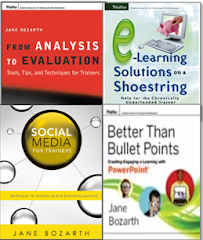 Want to make e-learning "better than bullet points"? Start by finding a way out of the static-content box and into an engaging treatment that invites application rather than regurgitation. Here, for example, are two ways of approaching an art history lesson. The first is the typical bullet-points approach; the second, an interactive mystery about a painting found in an attic. "A. Pintura: Art Detective" from Eduweb asks learners to evaluate, synthesize, and apply information rather than just memorize.
Want to make e-learning "better than bullet points"? Start by finding a way out of the static-content box and into an engaging treatment that invites application rather than regurgitation. Here, for example, are two ways of approaching an art history lesson. The first is the typical bullet-points approach; the second, an interactive mystery about a painting found in an attic. "A. Pintura: Art Detective" from Eduweb asks learners to evaluate, synthesize, and apply information rather than just memorize.See the bozarthzone main site for more examples-- and please send links to any you happen to run across!
Composite image from "Better than Bullet Points". Image from A.Pintura: Art Detective used with permission of Eduweb.






